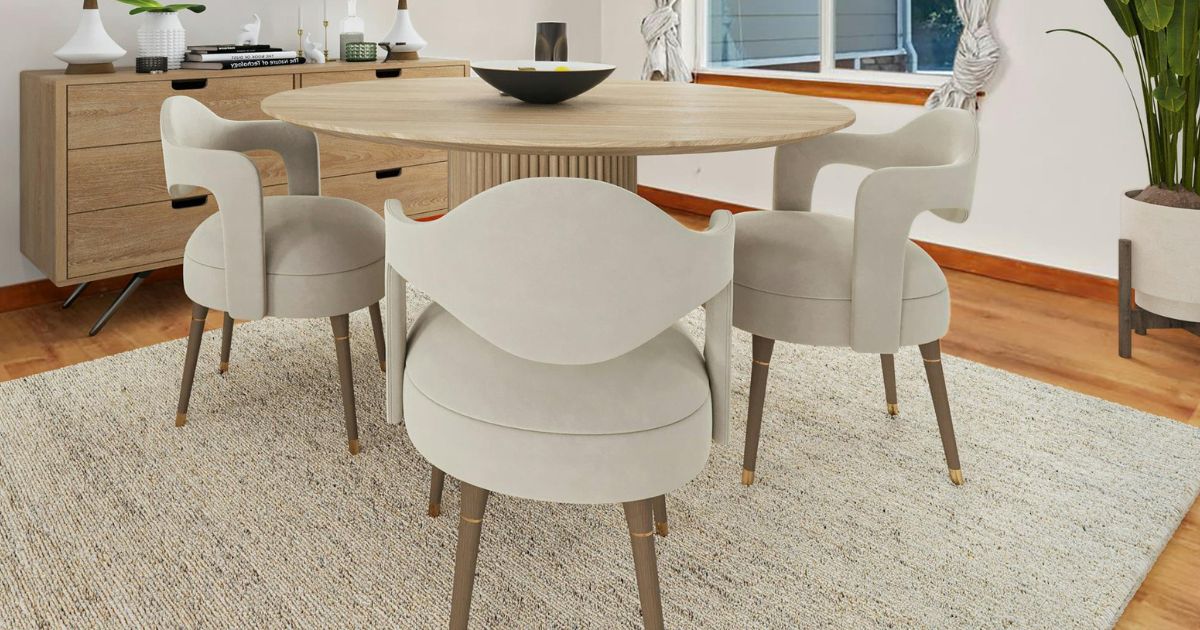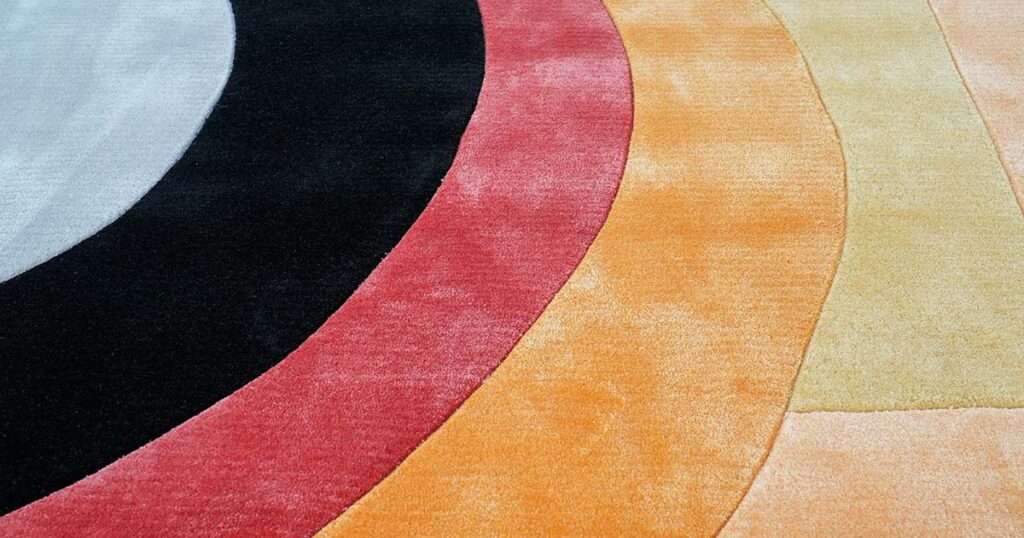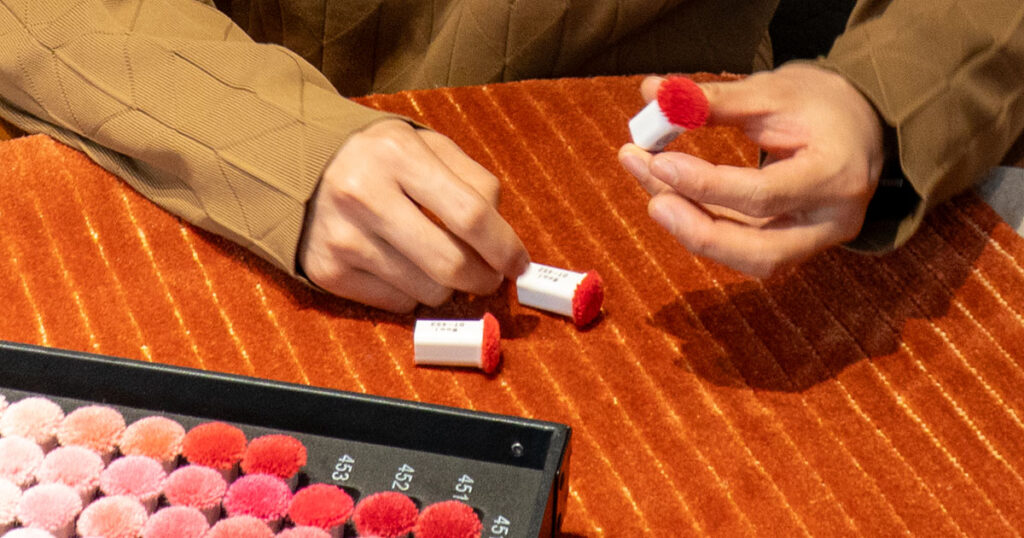White rugs have a special place in interior design.
They can transform a space entirely, making it feel more open, serene, or luxurious through color and design alone.
If you’re considering a white rug for your home or commercial space, this guide will help you understand what makes white rugs special and how to incorporate them beautifully into your space.
What White Means in Interior Design
White is far more than just a neutral color in interior design—it carries rich symbolic meanings and creates powerful emotional effects.
Symbolic Power of White
White represents purity, cleanliness, and freshness. It creates a sense of renewal in any space it occupies. Think about why spas and yoga studios often use white extensively—it evokes a feeling of cleanliness and tranquility.
White also functions as a “blank canvas” that allows other design elements to stand out. This quality helps make a room feel more open and spacious by reflecting light fully and visually expanding the area.
White’s Versatility in Design
One of white’s greatest strengths is its incredible versatility. Designers often note that “white goes with anything,” and it’s true—white pairs beautifully with nearly any other color or material. It makes vivid hues pop and frames them with crisp contrast.
White can be both calming and powerful simultaneously. It’s unobtrusive yet capable of setting a strong mood of clarity and harmony in a room.
Different Shades of White
Not all whites are created equal. There are hundreds of shades of white, each with its own subtle undertones that significantly impact the mood of your space.
Ivory: Warm Elegance
Ivory is a warm, neutral white with gentle yellow or beige undertones. Softer than pure white, ivory creates a timeless elegance and calm atmosphere. It offers the brightness of white but with enough warmth to feel inviting.
An ivory rug in a living room can transform the space into a calming sanctuary. Its soft presence makes a room feel cozy yet open, working beautifully in virtually any style of decor from classic to modern.
Cream: Cozy and Inviting
Cream-colored rugs feature more pronounced yellow, beige, or even peach undertones, introducing a cozy and inviting vibe. When pure white seems too stark, cream offers that hint of warmth that makes a room feel more alive and welcoming.
It’s an elegant yet approachable shade—often described as the perfect middle ground “when white seems too stark but beige seems too dark.” A cream rug casts a gentle glow in a space, contributing to a welcoming, timeless look that fits in both traditional and modern décor.
Pearl: Refined Tranquility
Pearl white is a cooler, very pale shade with subtle grey or iridescent undertones—similar to the inside of an oyster shell. A pearl-white rug conveys a sense of tranquility and refinement.
Pearl whites strike a nice balance between warmth and coolness—not as creamy as ivory, but not as harsh as bright white.
This balance makes them versatile in various settings.
A pearl-white rug adds a touch of delicate elegance to a room and pairs wonderfully with materials like wood or glass.
Snow: Crisp Brightness
“Snow” white refers to a very bright, crisp white—the color of fresh snow.
A snow-white rug brings instant clarity and brightness to any space, creating a fresh, clean, bright and airy feel.
Because it is so pure, a snow-white rug makes a space feel tranquil and light-filled.
Its crisp nature gives it a modern, clean look. Snow white rugs are perfect when you want to achieve an open, minimalistic atmosphere—they visually expand the room and make it appear larger.
Pairing White Rugs
White rugs have the remarkable ability to pair beautifully with almost any color scheme or material. This versatility allows them to adapt to virtually any design style.
White with Color Palettes
Because white is a neutral, it complements both cool colors and warm colors equally well. In a room with cool tones (blues, greens, grays), a white rug blends in calmly while making the cool scheme feel crisper and brighter. In spaces with warm tones (reds, oranges, browns), a white rug provides relief and contrast, balancing the warmth so the space doesn’t feel too heavy.
White has the power to highlight colors around it. A vividly colored wall or furniture piece appears even more eye-catching when positioned against white—for example, a brightly upholstered chair on a white rug will pop as a focal point.
Creating Contrast with White
One dramatic way to use a white rug is to set it against darker colors. In modern settings, pairing white with black or charcoal creates a striking monochrome palette.
Imagine a sleek office with inky black walls—a white rug would immediately stand out, adding elegance and contrast while bringing a soft, light element underfoot. The black-and-white combination is timeless and can feel either contemporary or vintage depending on your other choices.
Even just a white rug with bold black geometric patterns can create a graphic, high-contrast look that energizes a room—a popular choice in mid-century modern and urban contemporary designs.
Tone-on-Tone Layering with White
On the opposite end of the spectrum, a white rug can create a calm, layered look in a tone-on-tone neutral scheme. In a minimalist living room, you might have white walls, a white rug, and furniture in shades of white, beige, or gray.
To prevent the space from feeling flat or cold, introduce different textures and slightly different shades of white.
A soft off-white rug combined with brighter white drapes and cream-colored pillows creates subtle contrast among whites, resulting in a serene, cohesive environment that still maintains visual interest.
White Rugs and Natural Materials
White rugs pair excellently with natural materials like wood, stone, metal, and plants. Placing a white rug on hardwood floors is a classic choice—the neutral white lets the wood’s grain and color shine, while the wood’s warmth prevents the white from feeling too stark.
In modern spaces, pairing a white rug with glass or metal elements creates a sleek look. The rug’s clean color reflects light and emphasizes the shiny, smooth surfaces of metal and glass, giving a streamlined, contemporary feel.
White rugs next to indoor plants amplify a fresh, natural vibe—the green appears more vivid against white, creating a visually pleasing contrast.
White Rugs in Popular Interior Styles
Different interior design themes incorporate white rugs to achieve their signature looks. Let’s explore how white rugs fit into various popular styles.
Scandinavian: Bright and Cozy
Scandinavian design is known for bright, airy interiors and cozy minimalism (often called “hygge”). White rugs are essential in Scandi spaces, reinforcing brightness by reflecting daylight and making rooms feel more open and calm.
Scandinavian style often uses high-pile or fuzzy white rugs (like flokati or sheepskin) to add warmth through texture. The effect is a space that feels clean yet comforting. The white rug ties together the neutral palette and provides a soft spot for the eye and feet, balancing the sleek lines of modern Scandinavian furniture.
Minimalist: Serene Sophistication
Minimalist interiors favor simplicity, clean lines, and restrained color palettes. White is virtually the emblematic color of minimalism—it emphasizes form and space without adding visual clutter.
In a gallery-like living room with sparse furniture, a plain white rug might cover the floor to unify the seating area, allowing the eye to appreciate the shapes rather than drawing attention to itself. The room feels serene and uncluttered. White rugs in minimalism often are solid-colored with subtle texture, adding a touch of softness in what could otherwise be a stark room.
Classic/Traditional: Refined Balance
In classic or traditionally decorated spaces, white and off-white rugs bring balance and lightness. A fine ivory wool rug can ground a living room with mahogany furniture, floral drapes, and oil paintings, softening the overall look.
The neutral, soft tones of ivory or cream create a serene and sophisticated backdrop that blends with various decor styles. In formal settings, a white rug adds refinement—it allows the focus to be on the furniture shapes and beautiful wood tones, while the floor remains calm and subtle.
White rugs in traditional interiors help merge old and new elements. You can place classic pieces (like a Chesterfield sofa or a carved coffee table) on a simple light rug for a refreshed, updated traditional look.
Coastal: Fresh and Breezy
Coastal-inspired interiors often feature light, breezy colors with an emphasis on whites, blues, and sandy neutrals. A white rug fits perfectly with the coastal palette—it evokes images of soft sand and sea foam.
In a coastal living room, you might find slipcovered white sofas, sky-blue throw pillows, driftwood accents, and a textured white or off-white rug (perhaps a chunky woven cotton or bleached jute). The white rug contributes to the airy, relaxed vibe by keeping the color scheme light and helping bounce natural light throughout the room.
Blue, white, and green themed rooms create a refreshing coastal look. The white rug ensures the space doesn’t become too dark or intense; it maintains the brightness of a beach at noon.
Bohemian: Creative Balance
Boho interiors are eclectic, creative, and rich in layers. While boho rooms often have colorful elements, white and off-white rugs are actually very popular in bohemian decor because they provide a visual break amid the bold elements and help anchor the space.
The famous Moroccan Beni Ourain rug—a boho staple—typically has a white or cream wool base with simple geometric lines in black or brown. It’s loved in boho interiors for its plush texture and versatile pattern, bringing a sense of calm and sophistication even into a busy room.
White rugs in boho settings create an atmosphere of relaxation and creativity—they downplay formality and make the room feel more approachable despite abundant decor. They also highlight other pieces, allowing intricate patterns and colors to stand out against a neutral backdrop.
Luxe/Glamorous: Opulent Elegance
Luxe interiors frequently use white to exude high-end sophistication. White rugs in these schemes often appear as plush, high-pile carpets or rich textures that immediately signal opulence.
A silky white shag rug or a white faux-fur rug placed in a dressing room or lounge instantly adds a glam factor. In a luxe living room, you might pair a snow-white rug with velvet sofas, mirrored coffee tables, and gold lamps—the rug’s purity makes the metallic accents and jewel-tone fabrics stand out even more.
White is often used in luxury design because it implies exclusivity—only a pristine, well-kept space can maintain white furnishings! The atmosphere created by a white rug in a luxe setting is one of elegance and drama.
White Rugs in Different Spaces
White rugs play different roles depending on whether they’re used in homes or commercial spaces.
In Residential Spaces
In a home, a white rug is usually chosen to create a certain mood for the inhabitants—it’s about personal comfort, style, and daily atmosphere. Homeowners may use white rugs to make a room feel more open and serene, or to make a space feel cozy and personal.
Because home is a personal space, white rugs often highlight the homeowner’s taste and creativity. If someone loves minimalist aesthetics, a white rug underscores that preference; if someone has bold art on the walls, a white rug might balance and showcase that art.
The conceptual use of a white rug at home is often to provide a calming canvas for daily life—many people find that light colors help them feel relaxed and unconfined. Residential spaces also allow for more textural experimentation with white rugs purely for the pleasure of the occupants.
In Commercial Settings
In commercial settings—offices, hotels, retail stores—the use of a white rug is usually more strategic as part of branding or customer experience. A white rug in a public space instantly sends a message of sophistication and confidence.
Because white can be high-maintenance, seeing it in a commercial environment subconsciously tells visitors that the place is high-end, exclusive, or meant to be pristine. For example, a boutique with a white carpeted lounge area feels upscale because it implies attention to detail.
Commercial designers use white rugs to craft specific atmospheres: a white rug might make a boutique feel art-gallery-like by keeping surroundings neutral and focusing attention on merchandise, or it could make a hotel lobby feel grand and luminous.
Offices
In offices, especially creative studios or executive suites, white rugs can create impressive effects.
A white rug in a reception area makes the space feel sleek and forward-thinking.
The plush texture also softens acoustics and appearance, which can otherwise feel sterile with hard furniture.
A company might choose a white rug to convey that they are contemporary, cutting-edge, and unafraid of bold choices.
It can also make an office feel more comfortable—almost like a home living room—which might encourage creativity and relaxed thinking among employees.
Hotels
High-end hotels often use white in their interior schemes to evoke luxury and a sense of retreat.
A white rug or carpet in a hotel lobby immediately sets a tone of sophisticated elegance.
The symbolic meaning of white—purity and renewal—is valuable in hospitality: hotels want guests to feel they are entering a fresh, pristine space where they can relax completely.
White rugs in hotels help convey luxury, cleanliness, and tranquility, enhancing the guest experience.
Retail Spaces
Retail spaces use white rugs strategically to influence shopper behavior. A white rug creates a gallery-like backdrop that allows products to stand out.
Research shows that soft neutral colors like white create a soothing environment that doesn’t overwhelm customers, enabling them to focus on products.
In luxury retail, a plush white carpet signals exclusivity and amplifies the sparkle of jewelry or the elegance of fashion displays.
The atmosphere created by white rugs in retail is typically one of calm elegance and trust, encouraging customers to linger and explore.
Conclusion
By understanding the different shades of white, how to pair them with other elements.
And how they fit into various design styles, you can confidently choose a white rug that elevates your space to new heights of beauty and harmony.




